University Consumer Behavior Reflective Report - Semester Analysis
VerifiedAdded on 2022/08/20
|17
|5225
|14
Report
AI Summary
This reflective report offers a comprehensive analysis of consumer behavior, drawing upon three key activities undertaken during a marketing module. The report begins with an in-depth case study analysis, exploring the introduction to consumer behavior, and the influence of social and psychological factors on purchasing decisions. The analysis highlights the impact of social influences, such as family, peers, and cultural values, on consumer choices, often outweighing psychological factors like perception and motive. The second section delves into the consumer decision-making process, examining high and low involvement purchases and how they align with the textbook model. Finally, the report investigates the role of consumer attitudes, exploring the tri-component theory and the effectiveness of fear appeals in influencing behavior. The report provides valuable insights into consumer behavior and its implications for marketing strategies.
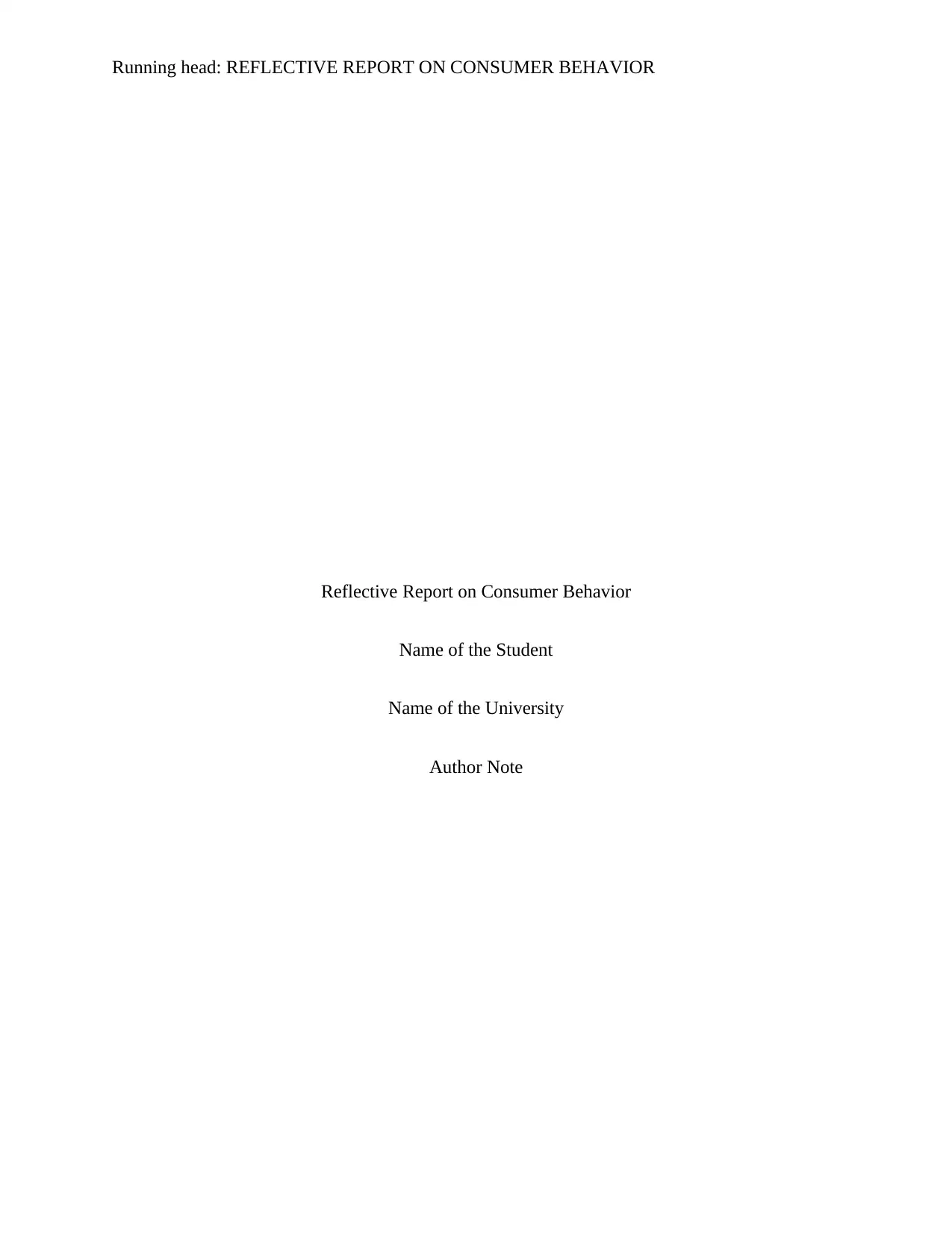
Running head: REFLECTIVE REPORT ON CONSUMER BEHAVIOR
Reflective Report on Consumer Behavior
Name of the Student
Name of the University
Author Note
Reflective Report on Consumer Behavior
Name of the Student
Name of the University
Author Note
Paraphrase This Document
Need a fresh take? Get an instant paraphrase of this document with our AI Paraphraser
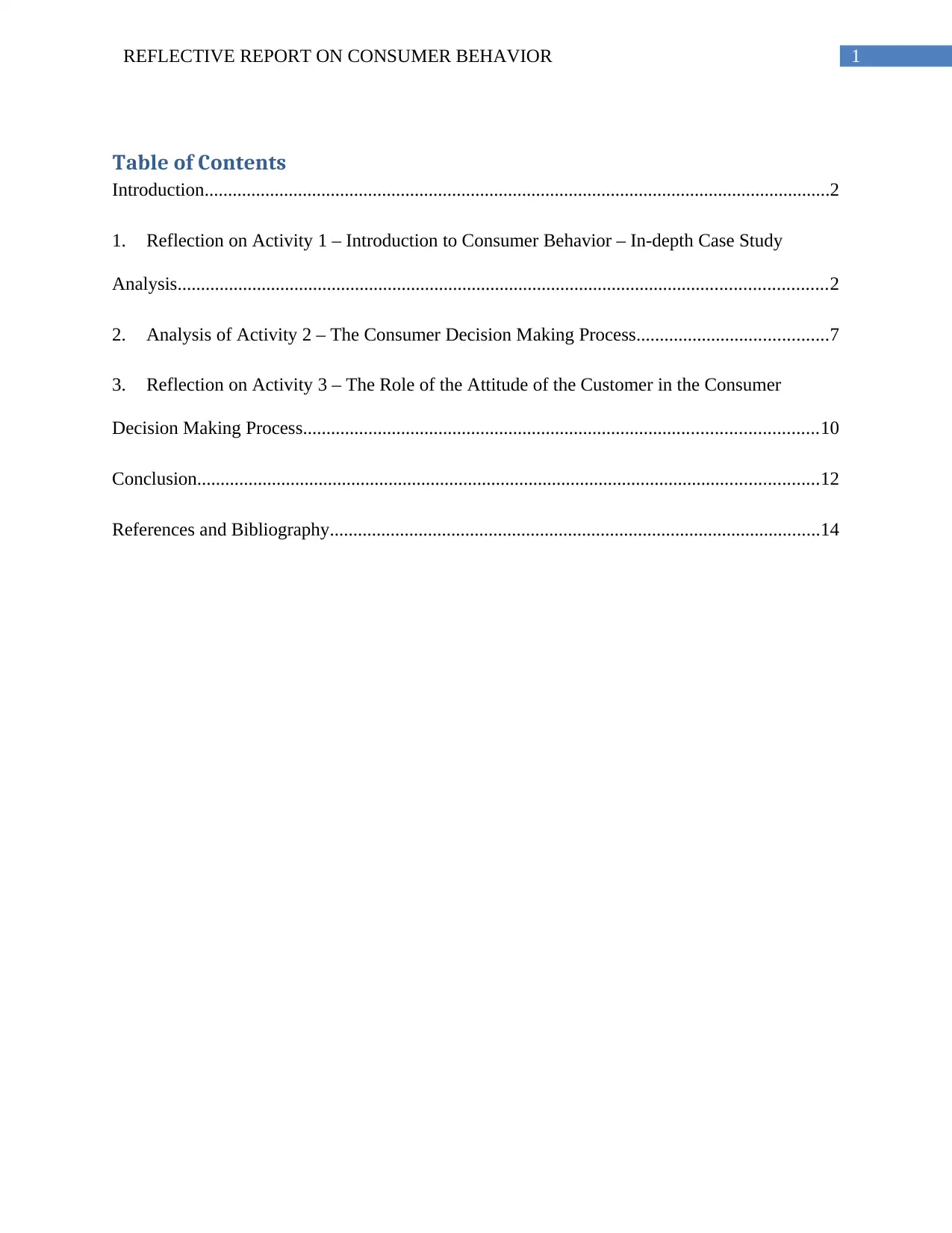
1REFLECTIVE REPORT ON CONSUMER BEHAVIOR
Table of Contents
Introduction......................................................................................................................................2
1. Reflection on Activity 1 – Introduction to Consumer Behavior – In-depth Case Study
Analysis...........................................................................................................................................2
2. Analysis of Activity 2 – The Consumer Decision Making Process.........................................7
3. Reflection on Activity 3 – The Role of the Attitude of the Customer in the Consumer
Decision Making Process..............................................................................................................10
Conclusion.....................................................................................................................................12
References and Bibliography.........................................................................................................14
Table of Contents
Introduction......................................................................................................................................2
1. Reflection on Activity 1 – Introduction to Consumer Behavior – In-depth Case Study
Analysis...........................................................................................................................................2
2. Analysis of Activity 2 – The Consumer Decision Making Process.........................................7
3. Reflection on Activity 3 – The Role of the Attitude of the Customer in the Consumer
Decision Making Process..............................................................................................................10
Conclusion.....................................................................................................................................12
References and Bibliography.........................................................................................................14
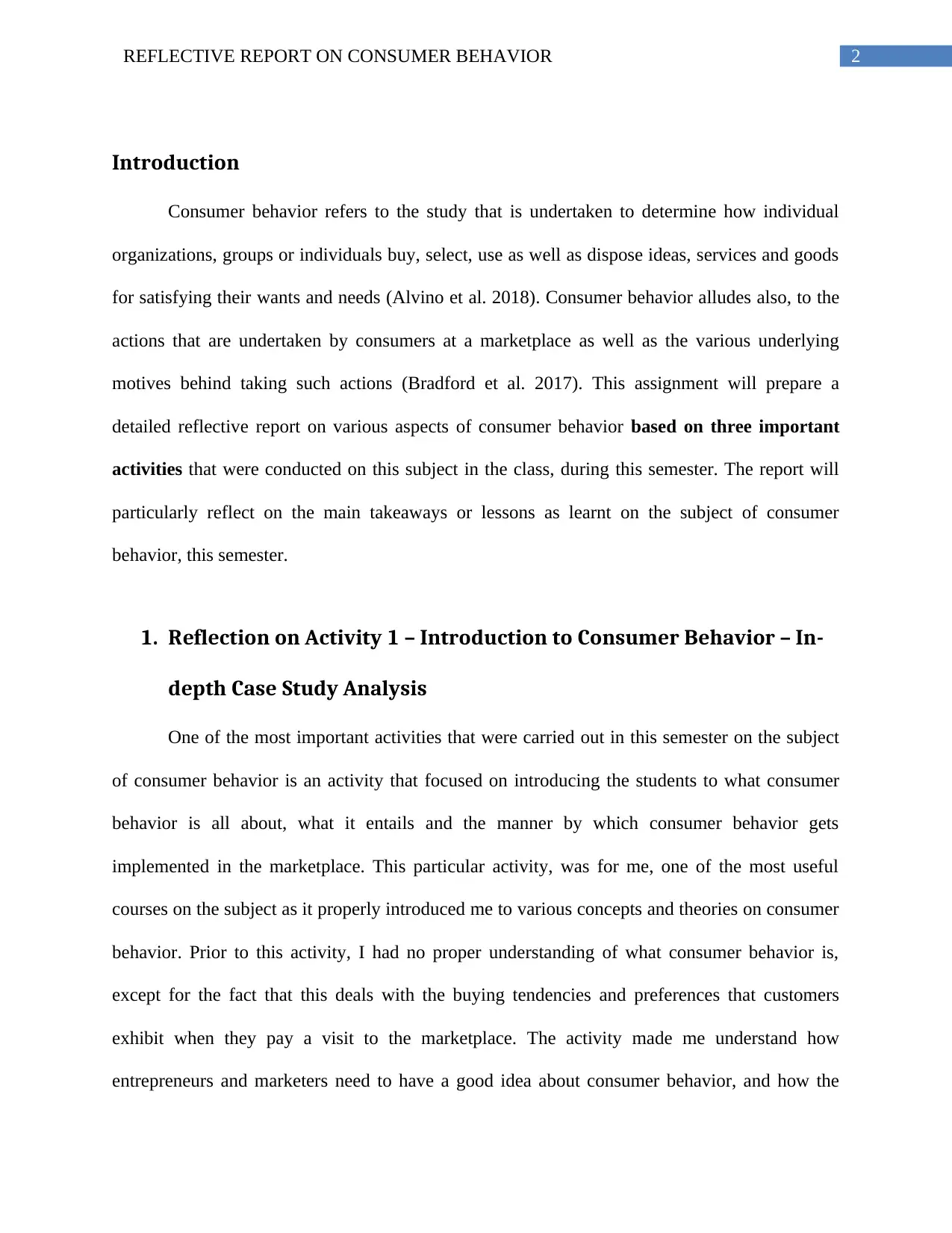
2REFLECTIVE REPORT ON CONSUMER BEHAVIOR
Introduction
Consumer behavior refers to the study that is undertaken to determine how individual
organizations, groups or individuals buy, select, use as well as dispose ideas, services and goods
for satisfying their wants and needs (Alvino et al. 2018). Consumer behavior alludes also, to the
actions that are undertaken by consumers at a marketplace as well as the various underlying
motives behind taking such actions (Bradford et al. 2017). This assignment will prepare a
detailed reflective report on various aspects of consumer behavior based on three important
activities that were conducted on this subject in the class, during this semester. The report will
particularly reflect on the main takeaways or lessons as learnt on the subject of consumer
behavior, this semester.
1. Reflection on Activity 1 – Introduction to Consumer Behavior – In-
depth Case Study Analysis
One of the most important activities that were carried out in this semester on the subject
of consumer behavior is an activity that focused on introducing the students to what consumer
behavior is all about, what it entails and the manner by which consumer behavior gets
implemented in the marketplace. This particular activity, was for me, one of the most useful
courses on the subject as it properly introduced me to various concepts and theories on consumer
behavior. Prior to this activity, I had no proper understanding of what consumer behavior is,
except for the fact that this deals with the buying tendencies and preferences that customers
exhibit when they pay a visit to the marketplace. The activity made me understand how
entrepreneurs and marketers need to have a good idea about consumer behavior, and how the
Introduction
Consumer behavior refers to the study that is undertaken to determine how individual
organizations, groups or individuals buy, select, use as well as dispose ideas, services and goods
for satisfying their wants and needs (Alvino et al. 2018). Consumer behavior alludes also, to the
actions that are undertaken by consumers at a marketplace as well as the various underlying
motives behind taking such actions (Bradford et al. 2017). This assignment will prepare a
detailed reflective report on various aspects of consumer behavior based on three important
activities that were conducted on this subject in the class, during this semester. The report will
particularly reflect on the main takeaways or lessons as learnt on the subject of consumer
behavior, this semester.
1. Reflection on Activity 1 – Introduction to Consumer Behavior – In-
depth Case Study Analysis
One of the most important activities that were carried out in this semester on the subject
of consumer behavior is an activity that focused on introducing the students to what consumer
behavior is all about, what it entails and the manner by which consumer behavior gets
implemented in the marketplace. This particular activity, was for me, one of the most useful
courses on the subject as it properly introduced me to various concepts and theories on consumer
behavior. Prior to this activity, I had no proper understanding of what consumer behavior is,
except for the fact that this deals with the buying tendencies and preferences that customers
exhibit when they pay a visit to the marketplace. The activity made me understand how
entrepreneurs and marketers need to have a good idea about consumer behavior, and how the
⊘ This is a preview!⊘
Do you want full access?
Subscribe today to unlock all pages.

Trusted by 1+ million students worldwide
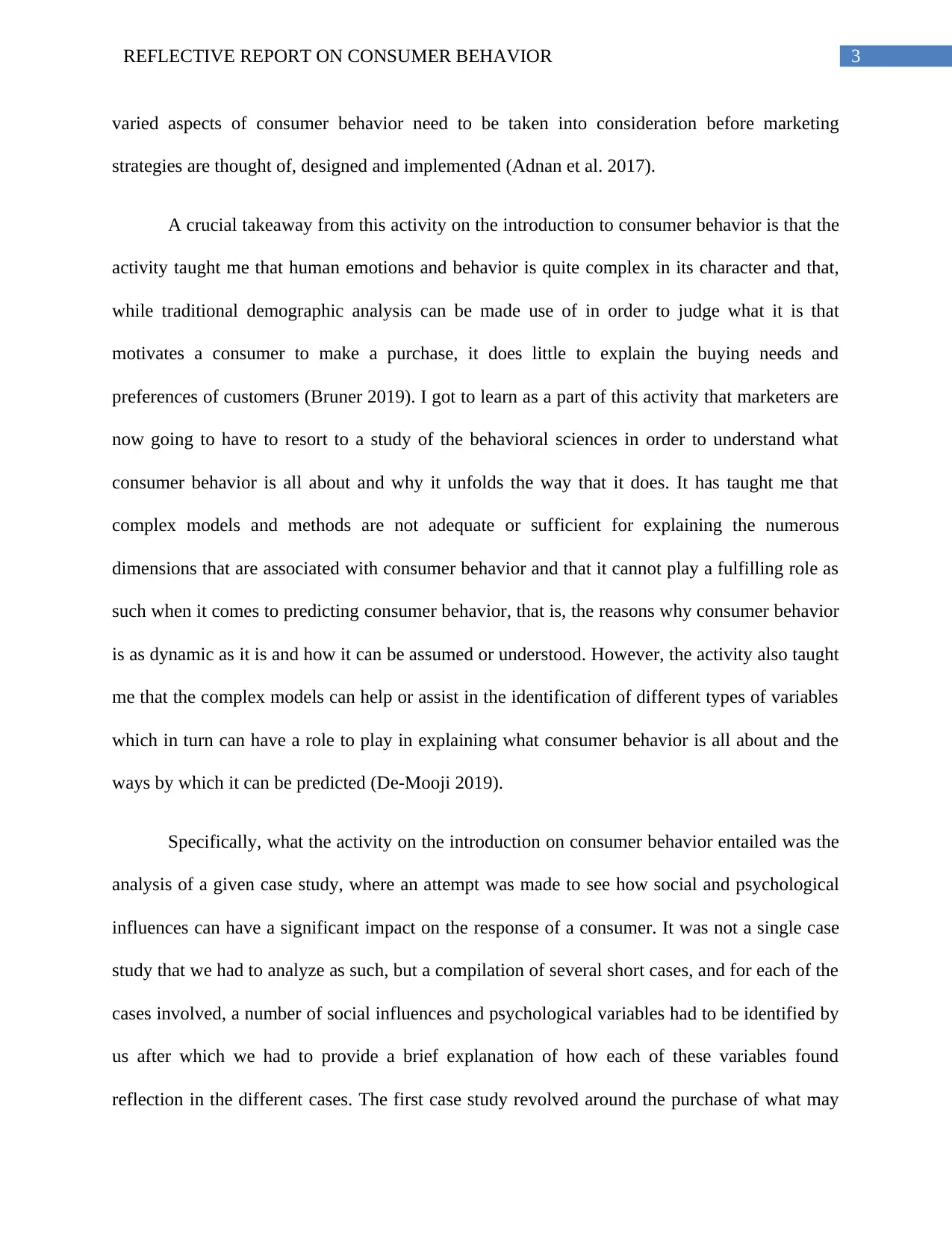
3REFLECTIVE REPORT ON CONSUMER BEHAVIOR
varied aspects of consumer behavior need to be taken into consideration before marketing
strategies are thought of, designed and implemented (Adnan et al. 2017).
A crucial takeaway from this activity on the introduction to consumer behavior is that the
activity taught me that human emotions and behavior is quite complex in its character and that,
while traditional demographic analysis can be made use of in order to judge what it is that
motivates a consumer to make a purchase, it does little to explain the buying needs and
preferences of customers (Bruner 2019). I got to learn as a part of this activity that marketers are
now going to have to resort to a study of the behavioral sciences in order to understand what
consumer behavior is all about and why it unfolds the way that it does. It has taught me that
complex models and methods are not adequate or sufficient for explaining the numerous
dimensions that are associated with consumer behavior and that it cannot play a fulfilling role as
such when it comes to predicting consumer behavior, that is, the reasons why consumer behavior
is as dynamic as it is and how it can be assumed or understood. However, the activity also taught
me that the complex models can help or assist in the identification of different types of variables
which in turn can have a role to play in explaining what consumer behavior is all about and the
ways by which it can be predicted (De-Mooji 2019).
Specifically, what the activity on the introduction on consumer behavior entailed was the
analysis of a given case study, where an attempt was made to see how social and psychological
influences can have a significant impact on the response of a consumer. It was not a single case
study that we had to analyze as such, but a compilation of several short cases, and for each of the
cases involved, a number of social influences and psychological variables had to be identified by
us after which we had to provide a brief explanation of how each of these variables found
reflection in the different cases. The first case study revolved around the purchase of what may
varied aspects of consumer behavior need to be taken into consideration before marketing
strategies are thought of, designed and implemented (Adnan et al. 2017).
A crucial takeaway from this activity on the introduction to consumer behavior is that the
activity taught me that human emotions and behavior is quite complex in its character and that,
while traditional demographic analysis can be made use of in order to judge what it is that
motivates a consumer to make a purchase, it does little to explain the buying needs and
preferences of customers (Bruner 2019). I got to learn as a part of this activity that marketers are
now going to have to resort to a study of the behavioral sciences in order to understand what
consumer behavior is all about and why it unfolds the way that it does. It has taught me that
complex models and methods are not adequate or sufficient for explaining the numerous
dimensions that are associated with consumer behavior and that it cannot play a fulfilling role as
such when it comes to predicting consumer behavior, that is, the reasons why consumer behavior
is as dynamic as it is and how it can be assumed or understood. However, the activity also taught
me that the complex models can help or assist in the identification of different types of variables
which in turn can have a role to play in explaining what consumer behavior is all about and the
ways by which it can be predicted (De-Mooji 2019).
Specifically, what the activity on the introduction on consumer behavior entailed was the
analysis of a given case study, where an attempt was made to see how social and psychological
influences can have a significant impact on the response of a consumer. It was not a single case
study that we had to analyze as such, but a compilation of several short cases, and for each of the
cases involved, a number of social influences and psychological variables had to be identified by
us after which we had to provide a brief explanation of how each of these variables found
reflection in the different cases. The first case study revolved around the purchase of what may
Paraphrase This Document
Need a fresh take? Get an instant paraphrase of this document with our AI Paraphraser
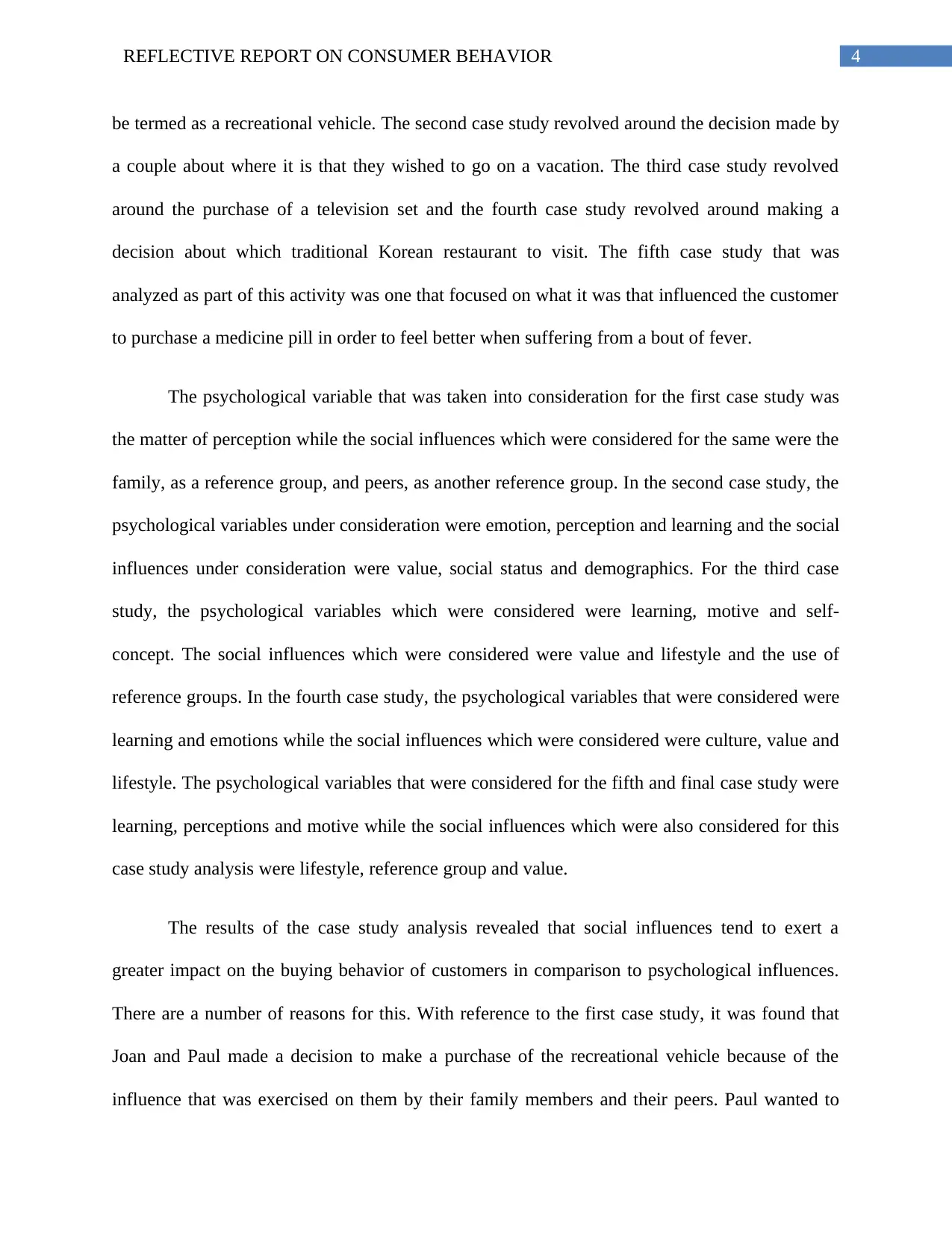
4REFLECTIVE REPORT ON CONSUMER BEHAVIOR
be termed as a recreational vehicle. The second case study revolved around the decision made by
a couple about where it is that they wished to go on a vacation. The third case study revolved
around the purchase of a television set and the fourth case study revolved around making a
decision about which traditional Korean restaurant to visit. The fifth case study that was
analyzed as part of this activity was one that focused on what it was that influenced the customer
to purchase a medicine pill in order to feel better when suffering from a bout of fever.
The psychological variable that was taken into consideration for the first case study was
the matter of perception while the social influences which were considered for the same were the
family, as a reference group, and peers, as another reference group. In the second case study, the
psychological variables under consideration were emotion, perception and learning and the social
influences under consideration were value, social status and demographics. For the third case
study, the psychological variables which were considered were learning, motive and self-
concept. The social influences which were considered were value and lifestyle and the use of
reference groups. In the fourth case study, the psychological variables that were considered were
learning and emotions while the social influences which were considered were culture, value and
lifestyle. The psychological variables that were considered for the fifth and final case study were
learning, perceptions and motive while the social influences which were also considered for this
case study analysis were lifestyle, reference group and value.
The results of the case study analysis revealed that social influences tend to exert a
greater impact on the buying behavior of customers in comparison to psychological influences.
There are a number of reasons for this. With reference to the first case study, it was found that
Joan and Paul made a decision to make a purchase of the recreational vehicle because of the
influence that was exercised on them by their family members and their peers. Paul wanted to
be termed as a recreational vehicle. The second case study revolved around the decision made by
a couple about where it is that they wished to go on a vacation. The third case study revolved
around the purchase of a television set and the fourth case study revolved around making a
decision about which traditional Korean restaurant to visit. The fifth case study that was
analyzed as part of this activity was one that focused on what it was that influenced the customer
to purchase a medicine pill in order to feel better when suffering from a bout of fever.
The psychological variable that was taken into consideration for the first case study was
the matter of perception while the social influences which were considered for the same were the
family, as a reference group, and peers, as another reference group. In the second case study, the
psychological variables under consideration were emotion, perception and learning and the social
influences under consideration were value, social status and demographics. For the third case
study, the psychological variables which were considered were learning, motive and self-
concept. The social influences which were considered were value and lifestyle and the use of
reference groups. In the fourth case study, the psychological variables that were considered were
learning and emotions while the social influences which were considered were culture, value and
lifestyle. The psychological variables that were considered for the fifth and final case study were
learning, perceptions and motive while the social influences which were also considered for this
case study analysis were lifestyle, reference group and value.
The results of the case study analysis revealed that social influences tend to exert a
greater impact on the buying behavior of customers in comparison to psychological influences.
There are a number of reasons for this. With reference to the first case study, it was found that
Joan and Paul made a decision to make a purchase of the recreational vehicle because of the
influence that was exercised on them by their family members and their peers. Paul wanted to
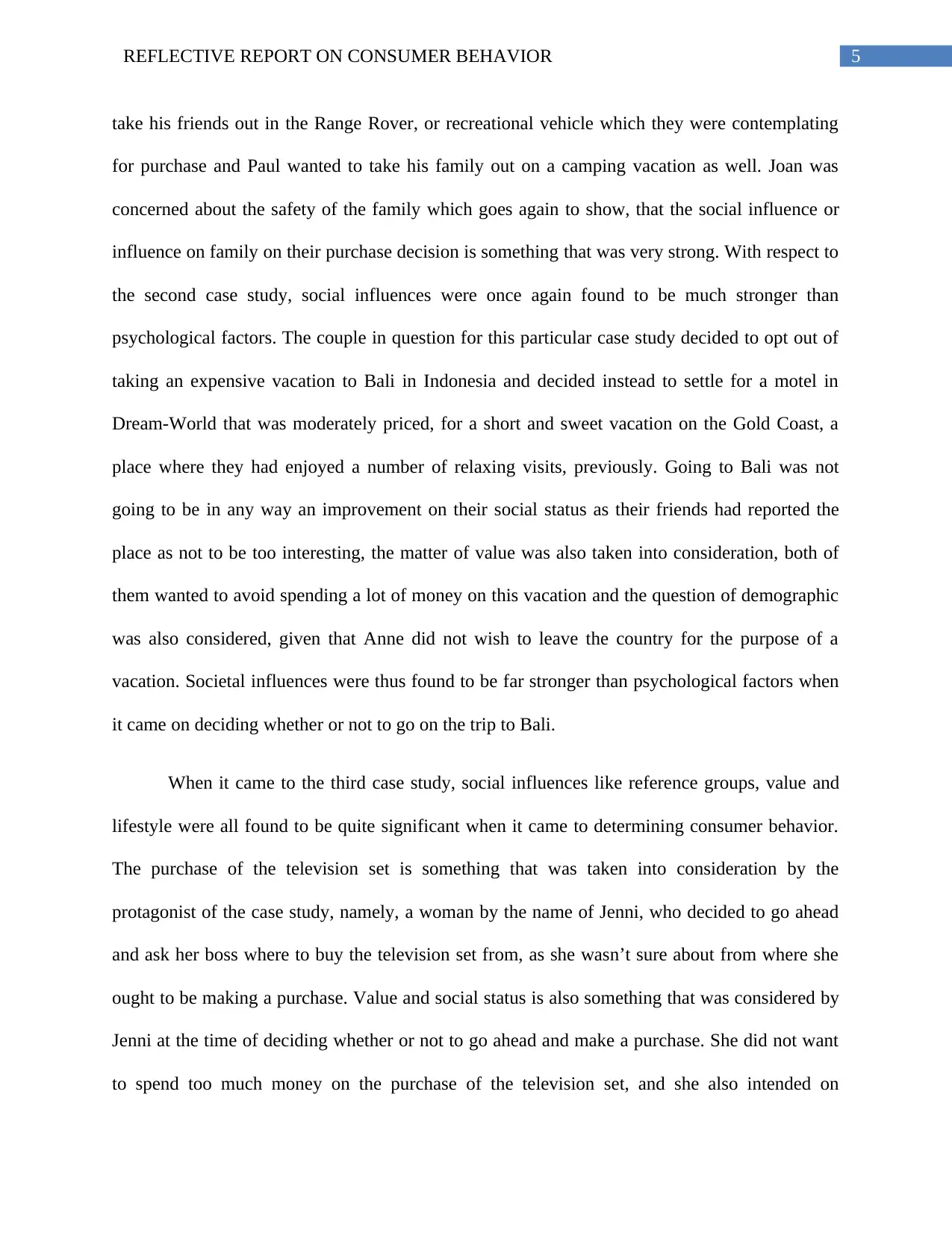
5REFLECTIVE REPORT ON CONSUMER BEHAVIOR
take his friends out in the Range Rover, or recreational vehicle which they were contemplating
for purchase and Paul wanted to take his family out on a camping vacation as well. Joan was
concerned about the safety of the family which goes again to show, that the social influence or
influence on family on their purchase decision is something that was very strong. With respect to
the second case study, social influences were once again found to be much stronger than
psychological factors. The couple in question for this particular case study decided to opt out of
taking an expensive vacation to Bali in Indonesia and decided instead to settle for a motel in
Dream-World that was moderately priced, for a short and sweet vacation on the Gold Coast, a
place where they had enjoyed a number of relaxing visits, previously. Going to Bali was not
going to be in any way an improvement on their social status as their friends had reported the
place as not to be too interesting, the matter of value was also taken into consideration, both of
them wanted to avoid spending a lot of money on this vacation and the question of demographic
was also considered, given that Anne did not wish to leave the country for the purpose of a
vacation. Societal influences were thus found to be far stronger than psychological factors when
it came on deciding whether or not to go on the trip to Bali.
When it came to the third case study, social influences like reference groups, value and
lifestyle were all found to be quite significant when it came to determining consumer behavior.
The purchase of the television set is something that was taken into consideration by the
protagonist of the case study, namely, a woman by the name of Jenni, who decided to go ahead
and ask her boss where to buy the television set from, as she wasn’t sure about from where she
ought to be making a purchase. Value and social status is also something that was considered by
Jenni at the time of deciding whether or not to go ahead and make a purchase. She did not want
to spend too much money on the purchase of the television set, and she also intended on
take his friends out in the Range Rover, or recreational vehicle which they were contemplating
for purchase and Paul wanted to take his family out on a camping vacation as well. Joan was
concerned about the safety of the family which goes again to show, that the social influence or
influence on family on their purchase decision is something that was very strong. With respect to
the second case study, social influences were once again found to be much stronger than
psychological factors. The couple in question for this particular case study decided to opt out of
taking an expensive vacation to Bali in Indonesia and decided instead to settle for a motel in
Dream-World that was moderately priced, for a short and sweet vacation on the Gold Coast, a
place where they had enjoyed a number of relaxing visits, previously. Going to Bali was not
going to be in any way an improvement on their social status as their friends had reported the
place as not to be too interesting, the matter of value was also taken into consideration, both of
them wanted to avoid spending a lot of money on this vacation and the question of demographic
was also considered, given that Anne did not wish to leave the country for the purpose of a
vacation. Societal influences were thus found to be far stronger than psychological factors when
it came on deciding whether or not to go on the trip to Bali.
When it came to the third case study, social influences like reference groups, value and
lifestyle were all found to be quite significant when it came to determining consumer behavior.
The purchase of the television set is something that was taken into consideration by the
protagonist of the case study, namely, a woman by the name of Jenni, who decided to go ahead
and ask her boss where to buy the television set from, as she wasn’t sure about from where she
ought to be making a purchase. Value and social status is also something that was considered by
Jenni at the time of deciding whether or not to go ahead and make a purchase. She did not want
to spend too much money on the purchase of the television set, and she also intended on
⊘ This is a preview!⊘
Do you want full access?
Subscribe today to unlock all pages.

Trusted by 1+ million students worldwide
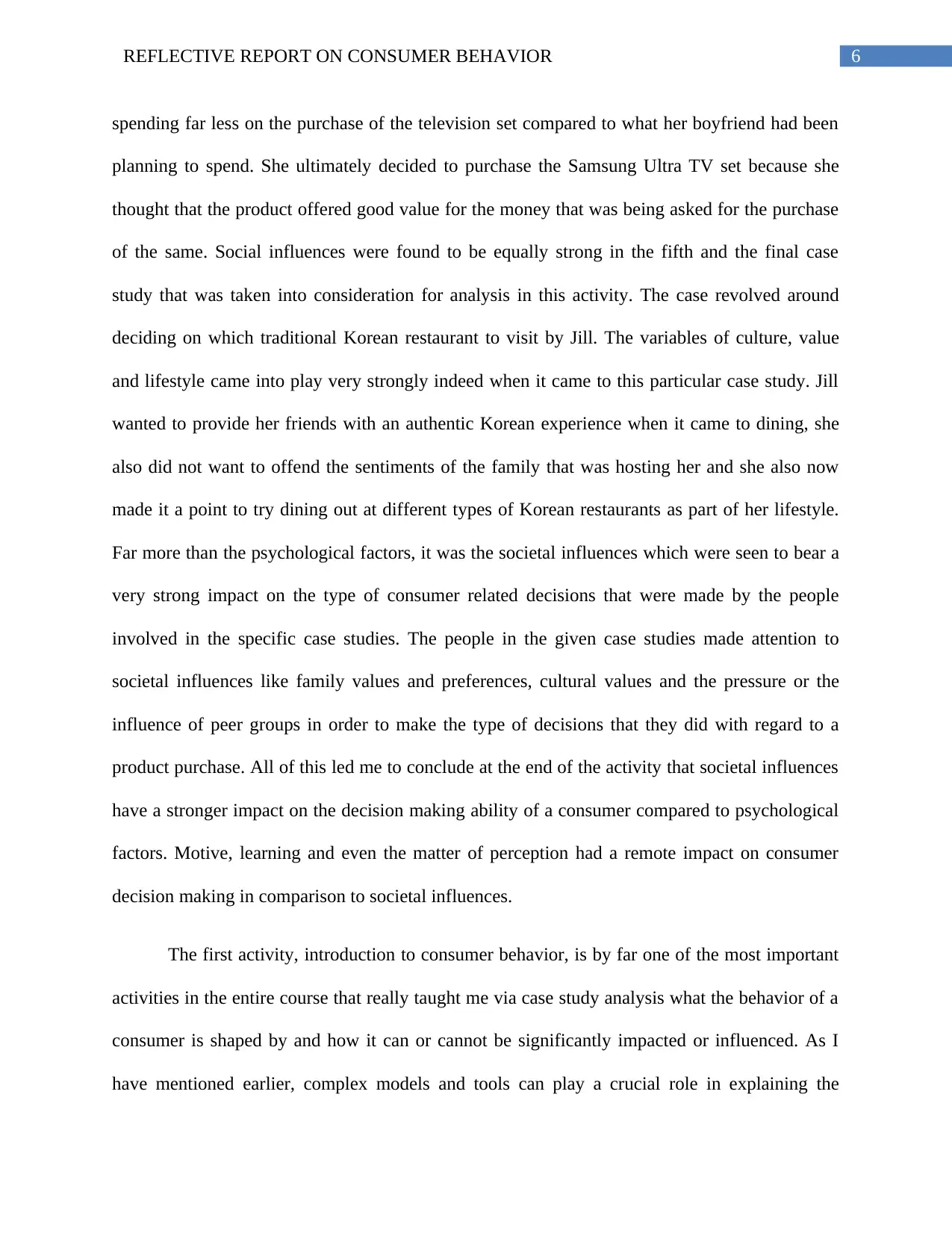
6REFLECTIVE REPORT ON CONSUMER BEHAVIOR
spending far less on the purchase of the television set compared to what her boyfriend had been
planning to spend. She ultimately decided to purchase the Samsung Ultra TV set because she
thought that the product offered good value for the money that was being asked for the purchase
of the same. Social influences were found to be equally strong in the fifth and the final case
study that was taken into consideration for analysis in this activity. The case revolved around
deciding on which traditional Korean restaurant to visit by Jill. The variables of culture, value
and lifestyle came into play very strongly indeed when it came to this particular case study. Jill
wanted to provide her friends with an authentic Korean experience when it came to dining, she
also did not want to offend the sentiments of the family that was hosting her and she also now
made it a point to try dining out at different types of Korean restaurants as part of her lifestyle.
Far more than the psychological factors, it was the societal influences which were seen to bear a
very strong impact on the type of consumer related decisions that were made by the people
involved in the specific case studies. The people in the given case studies made attention to
societal influences like family values and preferences, cultural values and the pressure or the
influence of peer groups in order to make the type of decisions that they did with regard to a
product purchase. All of this led me to conclude at the end of the activity that societal influences
have a stronger impact on the decision making ability of a consumer compared to psychological
factors. Motive, learning and even the matter of perception had a remote impact on consumer
decision making in comparison to societal influences.
The first activity, introduction to consumer behavior, is by far one of the most important
activities in the entire course that really taught me via case study analysis what the behavior of a
consumer is shaped by and how it can or cannot be significantly impacted or influenced. As I
have mentioned earlier, complex models and tools can play a crucial role in explaining the
spending far less on the purchase of the television set compared to what her boyfriend had been
planning to spend. She ultimately decided to purchase the Samsung Ultra TV set because she
thought that the product offered good value for the money that was being asked for the purchase
of the same. Social influences were found to be equally strong in the fifth and the final case
study that was taken into consideration for analysis in this activity. The case revolved around
deciding on which traditional Korean restaurant to visit by Jill. The variables of culture, value
and lifestyle came into play very strongly indeed when it came to this particular case study. Jill
wanted to provide her friends with an authentic Korean experience when it came to dining, she
also did not want to offend the sentiments of the family that was hosting her and she also now
made it a point to try dining out at different types of Korean restaurants as part of her lifestyle.
Far more than the psychological factors, it was the societal influences which were seen to bear a
very strong impact on the type of consumer related decisions that were made by the people
involved in the specific case studies. The people in the given case studies made attention to
societal influences like family values and preferences, cultural values and the pressure or the
influence of peer groups in order to make the type of decisions that they did with regard to a
product purchase. All of this led me to conclude at the end of the activity that societal influences
have a stronger impact on the decision making ability of a consumer compared to psychological
factors. Motive, learning and even the matter of perception had a remote impact on consumer
decision making in comparison to societal influences.
The first activity, introduction to consumer behavior, is by far one of the most important
activities in the entire course that really taught me via case study analysis what the behavior of a
consumer is shaped by and how it can or cannot be significantly impacted or influenced. As I
have mentioned earlier, complex models and tools can play a crucial role in explaining the
Paraphrase This Document
Need a fresh take? Get an instant paraphrase of this document with our AI Paraphraser
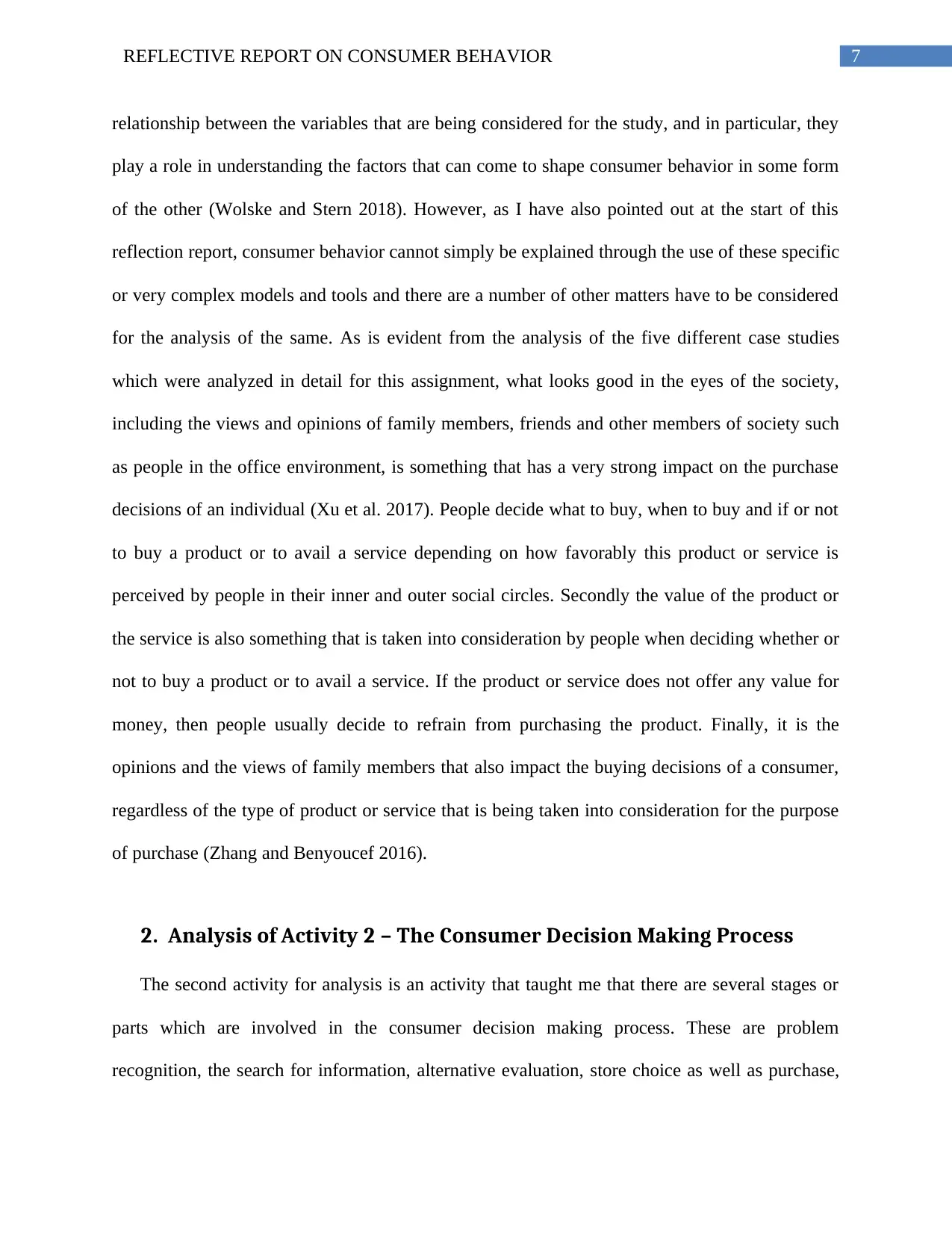
7REFLECTIVE REPORT ON CONSUMER BEHAVIOR
relationship between the variables that are being considered for the study, and in particular, they
play a role in understanding the factors that can come to shape consumer behavior in some form
of the other (Wolske and Stern 2018). However, as I have also pointed out at the start of this
reflection report, consumer behavior cannot simply be explained through the use of these specific
or very complex models and tools and there are a number of other matters have to be considered
for the analysis of the same. As is evident from the analysis of the five different case studies
which were analyzed in detail for this assignment, what looks good in the eyes of the society,
including the views and opinions of family members, friends and other members of society such
as people in the office environment, is something that has a very strong impact on the purchase
decisions of an individual (Xu et al. 2017). People decide what to buy, when to buy and if or not
to buy a product or to avail a service depending on how favorably this product or service is
perceived by people in their inner and outer social circles. Secondly the value of the product or
the service is also something that is taken into consideration by people when deciding whether or
not to buy a product or to avail a service. If the product or service does not offer any value for
money, then people usually decide to refrain from purchasing the product. Finally, it is the
opinions and the views of family members that also impact the buying decisions of a consumer,
regardless of the type of product or service that is being taken into consideration for the purpose
of purchase (Zhang and Benyoucef 2016).
2. Analysis of Activity 2 – The Consumer Decision Making Process
The second activity for analysis is an activity that taught me that there are several stages or
parts which are involved in the consumer decision making process. These are problem
recognition, the search for information, alternative evaluation, store choice as well as purchase,
relationship between the variables that are being considered for the study, and in particular, they
play a role in understanding the factors that can come to shape consumer behavior in some form
of the other (Wolske and Stern 2018). However, as I have also pointed out at the start of this
reflection report, consumer behavior cannot simply be explained through the use of these specific
or very complex models and tools and there are a number of other matters have to be considered
for the analysis of the same. As is evident from the analysis of the five different case studies
which were analyzed in detail for this assignment, what looks good in the eyes of the society,
including the views and opinions of family members, friends and other members of society such
as people in the office environment, is something that has a very strong impact on the purchase
decisions of an individual (Xu et al. 2017). People decide what to buy, when to buy and if or not
to buy a product or to avail a service depending on how favorably this product or service is
perceived by people in their inner and outer social circles. Secondly the value of the product or
the service is also something that is taken into consideration by people when deciding whether or
not to buy a product or to avail a service. If the product or service does not offer any value for
money, then people usually decide to refrain from purchasing the product. Finally, it is the
opinions and the views of family members that also impact the buying decisions of a consumer,
regardless of the type of product or service that is being taken into consideration for the purpose
of purchase (Zhang and Benyoucef 2016).
2. Analysis of Activity 2 – The Consumer Decision Making Process
The second activity for analysis is an activity that taught me that there are several stages or
parts which are involved in the consumer decision making process. These are problem
recognition, the search for information, alternative evaluation, store choice as well as purchase,
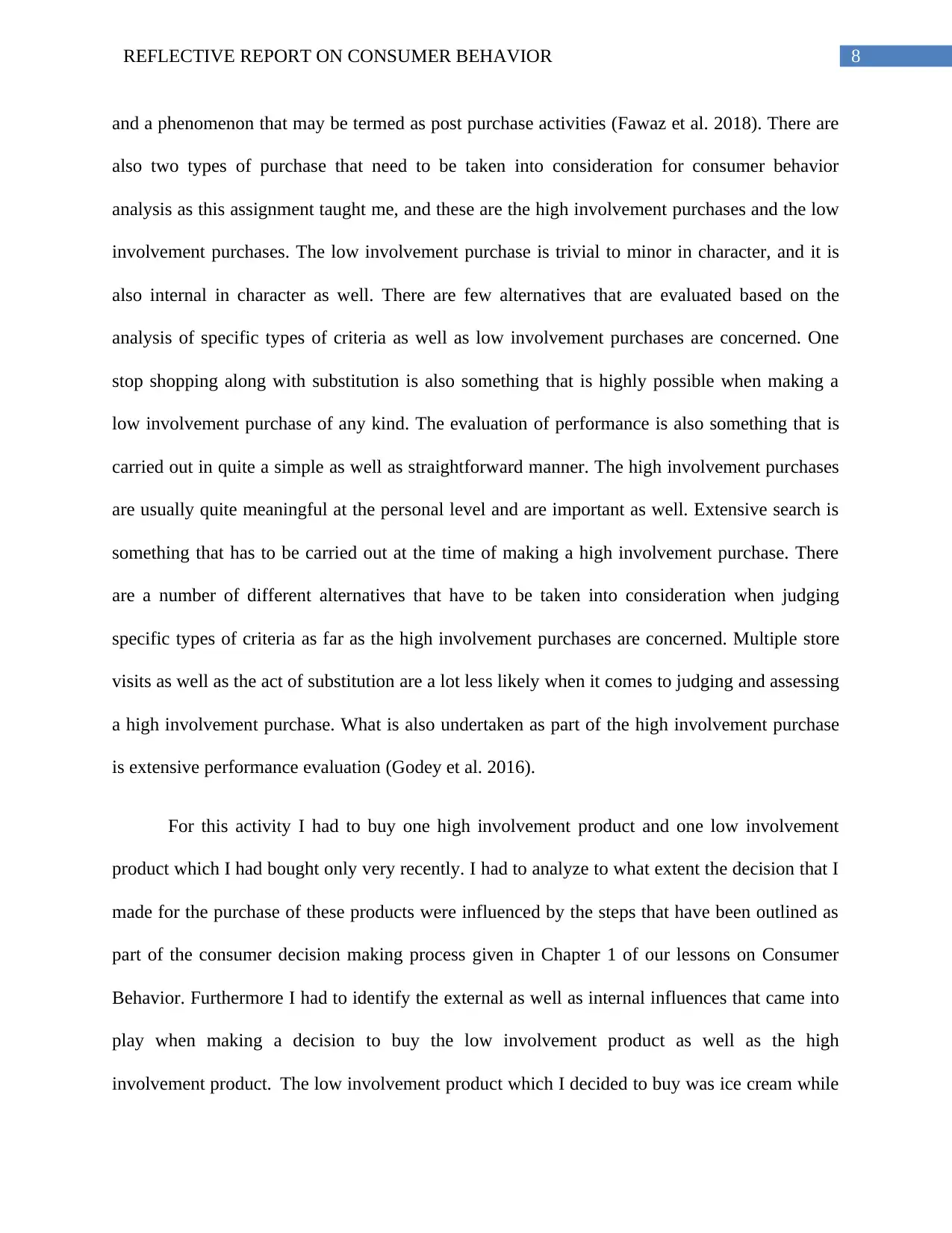
8REFLECTIVE REPORT ON CONSUMER BEHAVIOR
and a phenomenon that may be termed as post purchase activities (Fawaz et al. 2018). There are
also two types of purchase that need to be taken into consideration for consumer behavior
analysis as this assignment taught me, and these are the high involvement purchases and the low
involvement purchases. The low involvement purchase is trivial to minor in character, and it is
also internal in character as well. There are few alternatives that are evaluated based on the
analysis of specific types of criteria as well as low involvement purchases are concerned. One
stop shopping along with substitution is also something that is highly possible when making a
low involvement purchase of any kind. The evaluation of performance is also something that is
carried out in quite a simple as well as straightforward manner. The high involvement purchases
are usually quite meaningful at the personal level and are important as well. Extensive search is
something that has to be carried out at the time of making a high involvement purchase. There
are a number of different alternatives that have to be taken into consideration when judging
specific types of criteria as far as the high involvement purchases are concerned. Multiple store
visits as well as the act of substitution are a lot less likely when it comes to judging and assessing
a high involvement purchase. What is also undertaken as part of the high involvement purchase
is extensive performance evaluation (Godey et al. 2016).
For this activity I had to buy one high involvement product and one low involvement
product which I had bought only very recently. I had to analyze to what extent the decision that I
made for the purchase of these products were influenced by the steps that have been outlined as
part of the consumer decision making process given in Chapter 1 of our lessons on Consumer
Behavior. Furthermore I had to identify the external as well as internal influences that came into
play when making a decision to buy the low involvement product as well as the high
involvement product. The low involvement product which I decided to buy was ice cream while
and a phenomenon that may be termed as post purchase activities (Fawaz et al. 2018). There are
also two types of purchase that need to be taken into consideration for consumer behavior
analysis as this assignment taught me, and these are the high involvement purchases and the low
involvement purchases. The low involvement purchase is trivial to minor in character, and it is
also internal in character as well. There are few alternatives that are evaluated based on the
analysis of specific types of criteria as well as low involvement purchases are concerned. One
stop shopping along with substitution is also something that is highly possible when making a
low involvement purchase of any kind. The evaluation of performance is also something that is
carried out in quite a simple as well as straightforward manner. The high involvement purchases
are usually quite meaningful at the personal level and are important as well. Extensive search is
something that has to be carried out at the time of making a high involvement purchase. There
are a number of different alternatives that have to be taken into consideration when judging
specific types of criteria as far as the high involvement purchases are concerned. Multiple store
visits as well as the act of substitution are a lot less likely when it comes to judging and assessing
a high involvement purchase. What is also undertaken as part of the high involvement purchase
is extensive performance evaluation (Godey et al. 2016).
For this activity I had to buy one high involvement product and one low involvement
product which I had bought only very recently. I had to analyze to what extent the decision that I
made for the purchase of these products were influenced by the steps that have been outlined as
part of the consumer decision making process given in Chapter 1 of our lessons on Consumer
Behavior. Furthermore I had to identify the external as well as internal influences that came into
play when making a decision to buy the low involvement product as well as the high
involvement product. The low involvement product which I decided to buy was ice cream while
⊘ This is a preview!⊘
Do you want full access?
Subscribe today to unlock all pages.

Trusted by 1+ million students worldwide
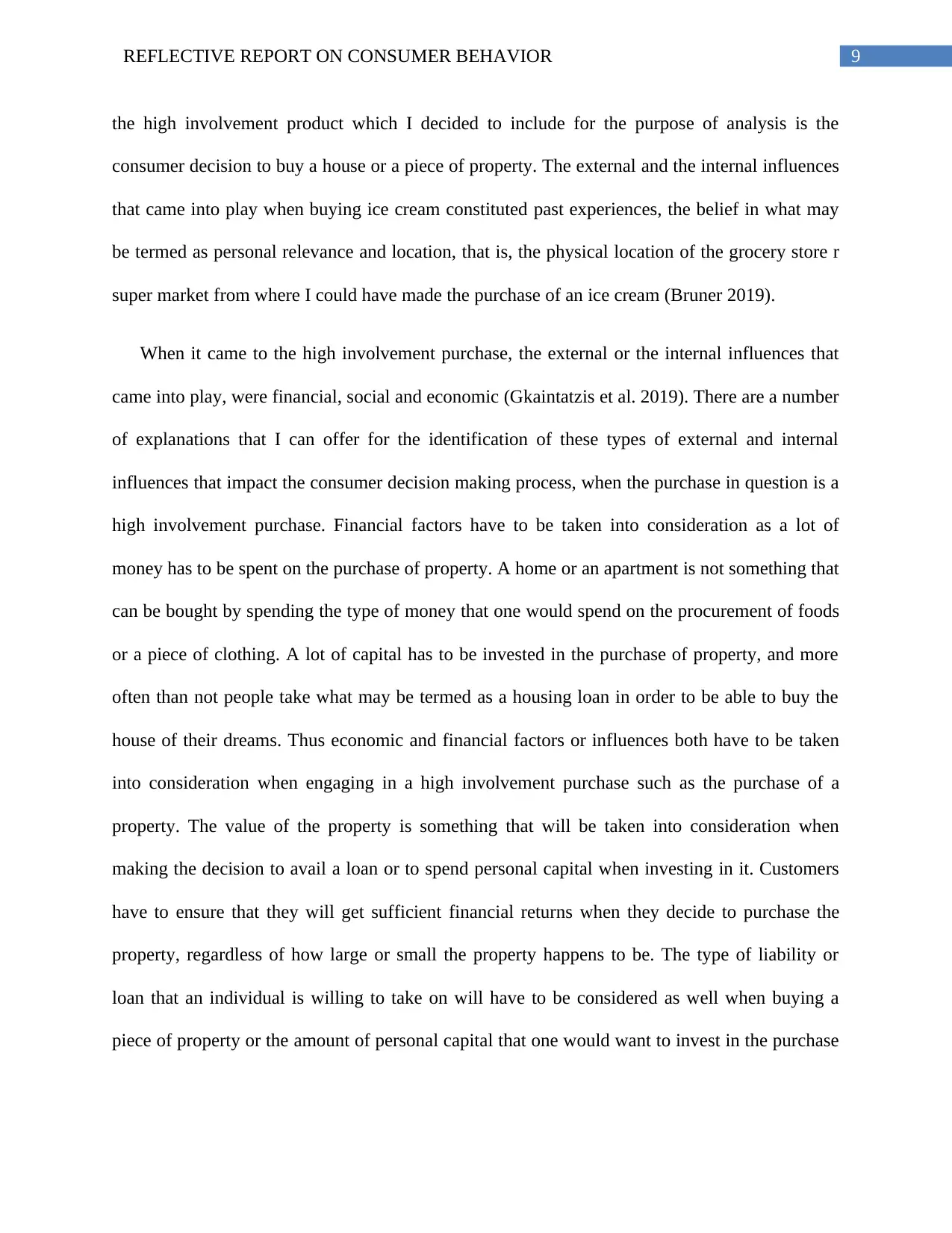
9REFLECTIVE REPORT ON CONSUMER BEHAVIOR
the high involvement product which I decided to include for the purpose of analysis is the
consumer decision to buy a house or a piece of property. The external and the internal influences
that came into play when buying ice cream constituted past experiences, the belief in what may
be termed as personal relevance and location, that is, the physical location of the grocery store r
super market from where I could have made the purchase of an ice cream (Bruner 2019).
When it came to the high involvement purchase, the external or the internal influences that
came into play, were financial, social and economic (Gkaintatzis et al. 2019). There are a number
of explanations that I can offer for the identification of these types of external and internal
influences that impact the consumer decision making process, when the purchase in question is a
high involvement purchase. Financial factors have to be taken into consideration as a lot of
money has to be spent on the purchase of property. A home or an apartment is not something that
can be bought by spending the type of money that one would spend on the procurement of foods
or a piece of clothing. A lot of capital has to be invested in the purchase of property, and more
often than not people take what may be termed as a housing loan in order to be able to buy the
house of their dreams. Thus economic and financial factors or influences both have to be taken
into consideration when engaging in a high involvement purchase such as the purchase of a
property. The value of the property is something that will be taken into consideration when
making the decision to avail a loan or to spend personal capital when investing in it. Customers
have to ensure that they will get sufficient financial returns when they decide to purchase the
property, regardless of how large or small the property happens to be. The type of liability or
loan that an individual is willing to take on will have to be considered as well when buying a
piece of property or the amount of personal capital that one would want to invest in the purchase
the high involvement product which I decided to include for the purpose of analysis is the
consumer decision to buy a house or a piece of property. The external and the internal influences
that came into play when buying ice cream constituted past experiences, the belief in what may
be termed as personal relevance and location, that is, the physical location of the grocery store r
super market from where I could have made the purchase of an ice cream (Bruner 2019).
When it came to the high involvement purchase, the external or the internal influences that
came into play, were financial, social and economic (Gkaintatzis et al. 2019). There are a number
of explanations that I can offer for the identification of these types of external and internal
influences that impact the consumer decision making process, when the purchase in question is a
high involvement purchase. Financial factors have to be taken into consideration as a lot of
money has to be spent on the purchase of property. A home or an apartment is not something that
can be bought by spending the type of money that one would spend on the procurement of foods
or a piece of clothing. A lot of capital has to be invested in the purchase of property, and more
often than not people take what may be termed as a housing loan in order to be able to buy the
house of their dreams. Thus economic and financial factors or influences both have to be taken
into consideration when engaging in a high involvement purchase such as the purchase of a
property. The value of the property is something that will be taken into consideration when
making the decision to avail a loan or to spend personal capital when investing in it. Customers
have to ensure that they will get sufficient financial returns when they decide to purchase the
property, regardless of how large or small the property happens to be. The type of liability or
loan that an individual is willing to take on will have to be considered as well when buying a
piece of property or the amount of personal capital that one would want to invest in the purchase
Paraphrase This Document
Need a fresh take? Get an instant paraphrase of this document with our AI Paraphraser
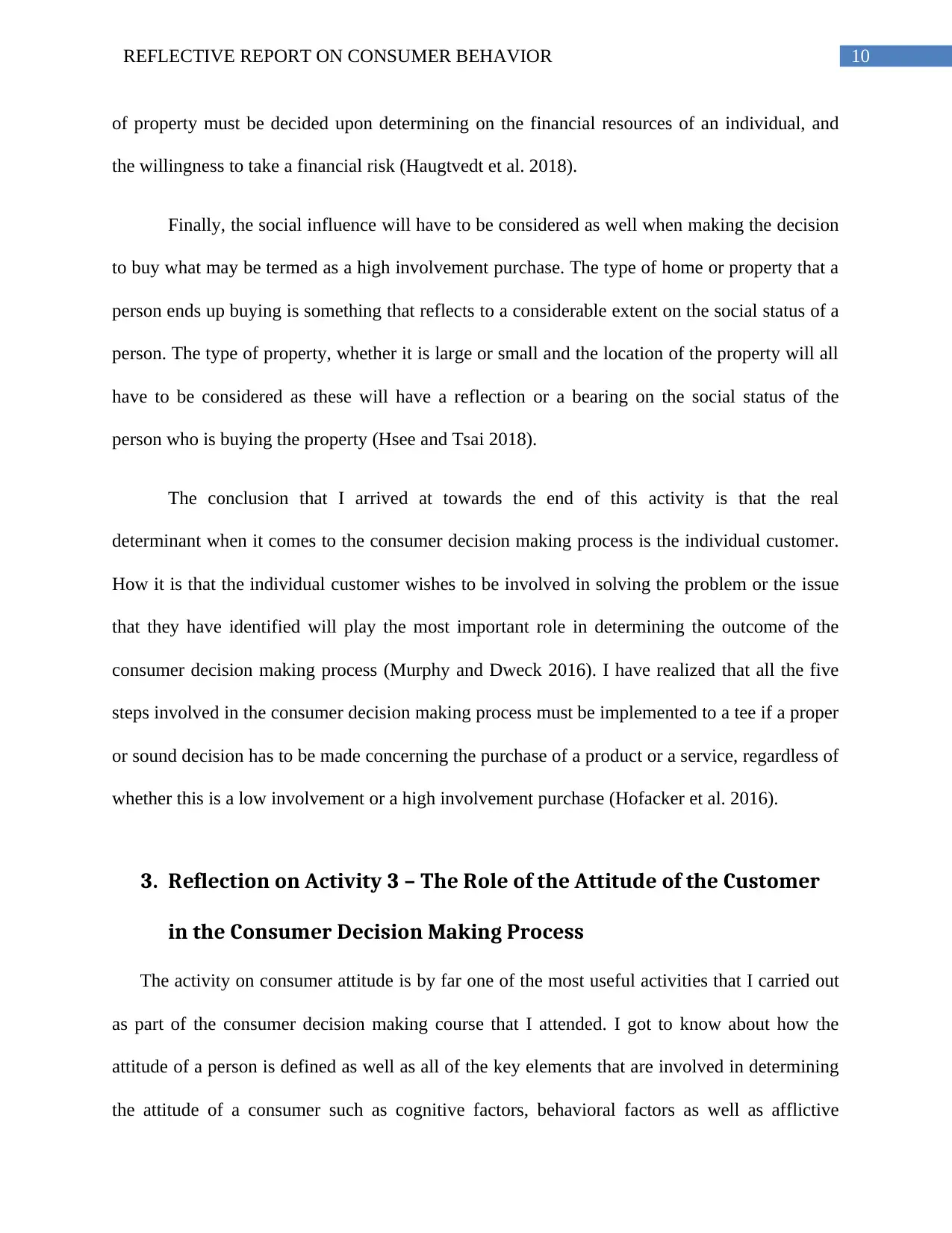
10REFLECTIVE REPORT ON CONSUMER BEHAVIOR
of property must be decided upon determining on the financial resources of an individual, and
the willingness to take a financial risk (Haugtvedt et al. 2018).
Finally, the social influence will have to be considered as well when making the decision
to buy what may be termed as a high involvement purchase. The type of home or property that a
person ends up buying is something that reflects to a considerable extent on the social status of a
person. The type of property, whether it is large or small and the location of the property will all
have to be considered as these will have a reflection or a bearing on the social status of the
person who is buying the property (Hsee and Tsai 2018).
The conclusion that I arrived at towards the end of this activity is that the real
determinant when it comes to the consumer decision making process is the individual customer.
How it is that the individual customer wishes to be involved in solving the problem or the issue
that they have identified will play the most important role in determining the outcome of the
consumer decision making process (Murphy and Dweck 2016). I have realized that all the five
steps involved in the consumer decision making process must be implemented to a tee if a proper
or sound decision has to be made concerning the purchase of a product or a service, regardless of
whether this is a low involvement or a high involvement purchase (Hofacker et al. 2016).
3. Reflection on Activity 3 – The Role of the Attitude of the Customer
in the Consumer Decision Making Process
The activity on consumer attitude is by far one of the most useful activities that I carried out
as part of the consumer decision making course that I attended. I got to know about how the
attitude of a person is defined as well as all of the key elements that are involved in determining
the attitude of a consumer such as cognitive factors, behavioral factors as well as afflictive
of property must be decided upon determining on the financial resources of an individual, and
the willingness to take a financial risk (Haugtvedt et al. 2018).
Finally, the social influence will have to be considered as well when making the decision
to buy what may be termed as a high involvement purchase. The type of home or property that a
person ends up buying is something that reflects to a considerable extent on the social status of a
person. The type of property, whether it is large or small and the location of the property will all
have to be considered as these will have a reflection or a bearing on the social status of the
person who is buying the property (Hsee and Tsai 2018).
The conclusion that I arrived at towards the end of this activity is that the real
determinant when it comes to the consumer decision making process is the individual customer.
How it is that the individual customer wishes to be involved in solving the problem or the issue
that they have identified will play the most important role in determining the outcome of the
consumer decision making process (Murphy and Dweck 2016). I have realized that all the five
steps involved in the consumer decision making process must be implemented to a tee if a proper
or sound decision has to be made concerning the purchase of a product or a service, regardless of
whether this is a low involvement or a high involvement purchase (Hofacker et al. 2016).
3. Reflection on Activity 3 – The Role of the Attitude of the Customer
in the Consumer Decision Making Process
The activity on consumer attitude is by far one of the most useful activities that I carried out
as part of the consumer decision making course that I attended. I got to know about how the
attitude of a person is defined as well as all of the key elements that are involved in determining
the attitude of a consumer such as cognitive factors, behavioral factors as well as afflictive
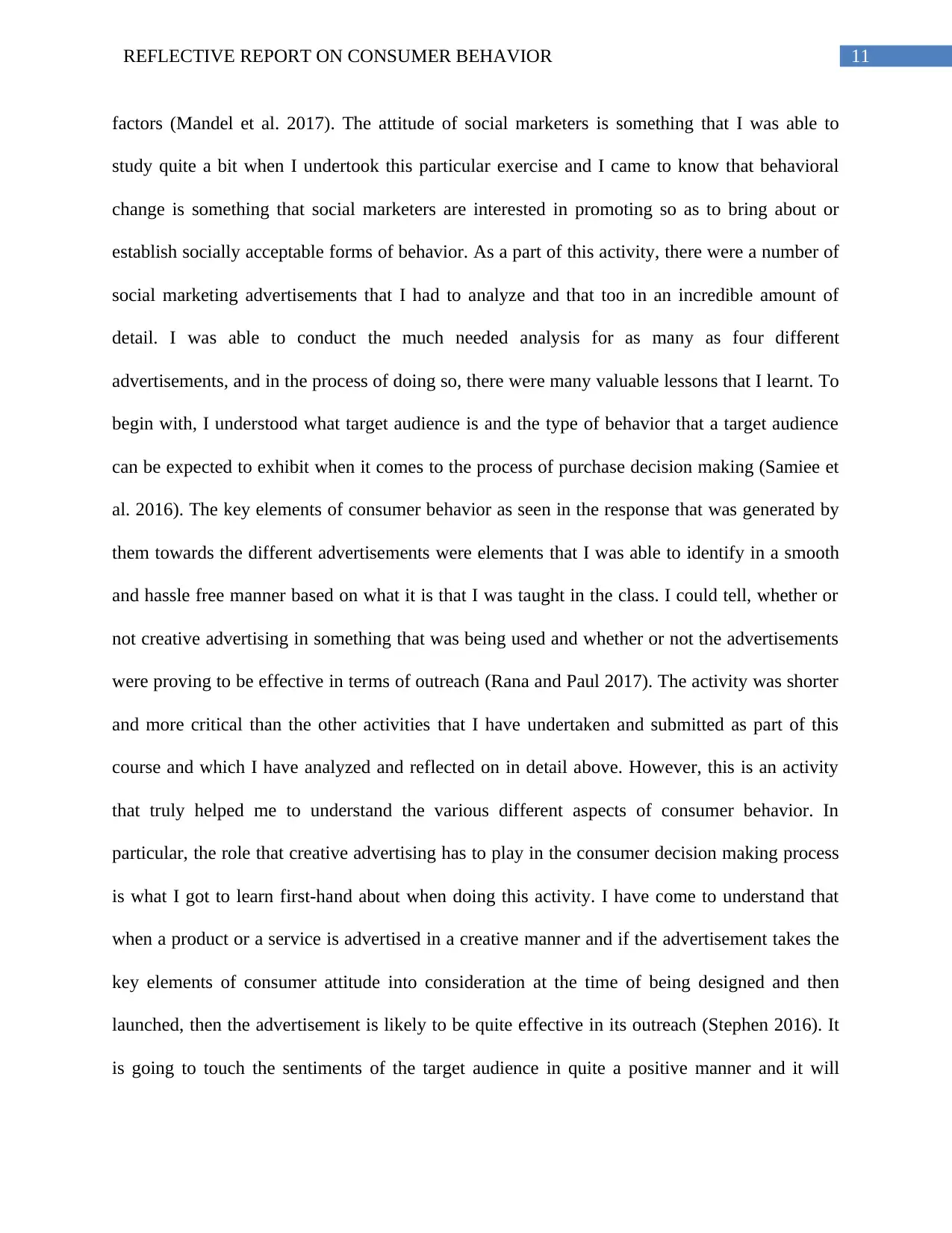
11REFLECTIVE REPORT ON CONSUMER BEHAVIOR
factors (Mandel et al. 2017). The attitude of social marketers is something that I was able to
study quite a bit when I undertook this particular exercise and I came to know that behavioral
change is something that social marketers are interested in promoting so as to bring about or
establish socially acceptable forms of behavior. As a part of this activity, there were a number of
social marketing advertisements that I had to analyze and that too in an incredible amount of
detail. I was able to conduct the much needed analysis for as many as four different
advertisements, and in the process of doing so, there were many valuable lessons that I learnt. To
begin with, I understood what target audience is and the type of behavior that a target audience
can be expected to exhibit when it comes to the process of purchase decision making (Samiee et
al. 2016). The key elements of consumer behavior as seen in the response that was generated by
them towards the different advertisements were elements that I was able to identify in a smooth
and hassle free manner based on what it is that I was taught in the class. I could tell, whether or
not creative advertising in something that was being used and whether or not the advertisements
were proving to be effective in terms of outreach (Rana and Paul 2017). The activity was shorter
and more critical than the other activities that I have undertaken and submitted as part of this
course and which I have analyzed and reflected on in detail above. However, this is an activity
that truly helped me to understand the various different aspects of consumer behavior. In
particular, the role that creative advertising has to play in the consumer decision making process
is what I got to learn first-hand about when doing this activity. I have come to understand that
when a product or a service is advertised in a creative manner and if the advertisement takes the
key elements of consumer attitude into consideration at the time of being designed and then
launched, then the advertisement is likely to be quite effective in its outreach (Stephen 2016). It
is going to touch the sentiments of the target audience in quite a positive manner and it will
factors (Mandel et al. 2017). The attitude of social marketers is something that I was able to
study quite a bit when I undertook this particular exercise and I came to know that behavioral
change is something that social marketers are interested in promoting so as to bring about or
establish socially acceptable forms of behavior. As a part of this activity, there were a number of
social marketing advertisements that I had to analyze and that too in an incredible amount of
detail. I was able to conduct the much needed analysis for as many as four different
advertisements, and in the process of doing so, there were many valuable lessons that I learnt. To
begin with, I understood what target audience is and the type of behavior that a target audience
can be expected to exhibit when it comes to the process of purchase decision making (Samiee et
al. 2016). The key elements of consumer behavior as seen in the response that was generated by
them towards the different advertisements were elements that I was able to identify in a smooth
and hassle free manner based on what it is that I was taught in the class. I could tell, whether or
not creative advertising in something that was being used and whether or not the advertisements
were proving to be effective in terms of outreach (Rana and Paul 2017). The activity was shorter
and more critical than the other activities that I have undertaken and submitted as part of this
course and which I have analyzed and reflected on in detail above. However, this is an activity
that truly helped me to understand the various different aspects of consumer behavior. In
particular, the role that creative advertising has to play in the consumer decision making process
is what I got to learn first-hand about when doing this activity. I have come to understand that
when a product or a service is advertised in a creative manner and if the advertisement takes the
key elements of consumer attitude into consideration at the time of being designed and then
launched, then the advertisement is likely to be quite effective in its outreach (Stephen 2016). It
is going to touch the sentiments of the target audience in quite a positive manner and it will
⊘ This is a preview!⊘
Do you want full access?
Subscribe today to unlock all pages.

Trusted by 1+ million students worldwide
1 out of 17
Related Documents
Your All-in-One AI-Powered Toolkit for Academic Success.
+13062052269
info@desklib.com
Available 24*7 on WhatsApp / Email
![[object Object]](/_next/static/media/star-bottom.7253800d.svg)
Unlock your academic potential
Copyright © 2020–2025 A2Z Services. All Rights Reserved. Developed and managed by ZUCOL.





